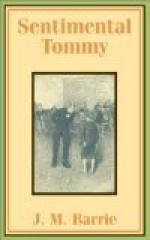Only on great occasions were the boys and girls admitted to the blue-and-white room, when they were given shortbread, but had to eat it with their heads flung back so that no crumbs should fall. Nearly everything in this room was blue or white, or both. There were white blinds and blue curtains, a blue table-cover and a white crumb-cloth, a white sheepskin with a blue footstool on it, blue chairs dotted with white buttons. Only white flowers came into this room, where there were blue vases for them, not a book was to be seen without a blue alpaca cover. Here Miss Ailie received visitors in her white with the blue braid, and enrolled new pupils in blue ink with a white pen. Some laughed at her, others remembered that she must have something to love after Miss Kitty died.
Miss Ailie had her romance, as you may hear by and by, but you would not have thought it as she came forward to meet you in the blue-and-white room, trembling lest your feet had brought in mud, but too much a lady to ask you to stand on a newspaper, as she would have liked dearly to do. She was somewhat beyond middle-age, and stoutly, even squarely, built, which gave her a masculine appearance; but she had grown so timid since Miss Kitty’s death that when she spoke you felt that either her figure or her manner must have been intended for someone else. In conversation she had a way of ending a sentence in the middle which gave her a reputation of being “thro’ither,” though an artificial tooth was the cause. It was slightly loose, and had she not at times shut her mouth suddenly, and then done something with her tongue, an accident might have happened. This tooth fascinated Tommy, and once when she was talking he cried, excitedly, “Quick, it’s coming!” whereupon her mouth snapped close, and she turned pink in the blue-and-white room.
Nevertheless Tommy became her favorite, and as he had taught himself to read, after a fashion, in London, where his lesson-books were chiefly placards and the journal subscribed to by Shovel’s father, she often invited him after school hours to the blue-and-white room, where he sat on a kitchen chair (with his boots off) and read aloud, very slowly, while Miss Ailie knitted. The volume was from the Thrums Book Club, of which Miss Ailie was one of the twelve members. Each member contributed a book every year, and as their tastes in literature differed, all sorts of books came into the club, and there was one member who invariably gave a ro-ro-romance. He was double-chinned and forty, but the school-mistress called him the dashing young banker, and for months she avoided his dangerous contribution. But always there came a black day when a desire to read the novel seized her, and she hurried home with it beneath her rokelay. This year the dashing banker’s choice was a lady’s novel called “I Love My Love with an A,” and it was a frivolous tale, those being before the days of the new fiction, with its grand discovery




